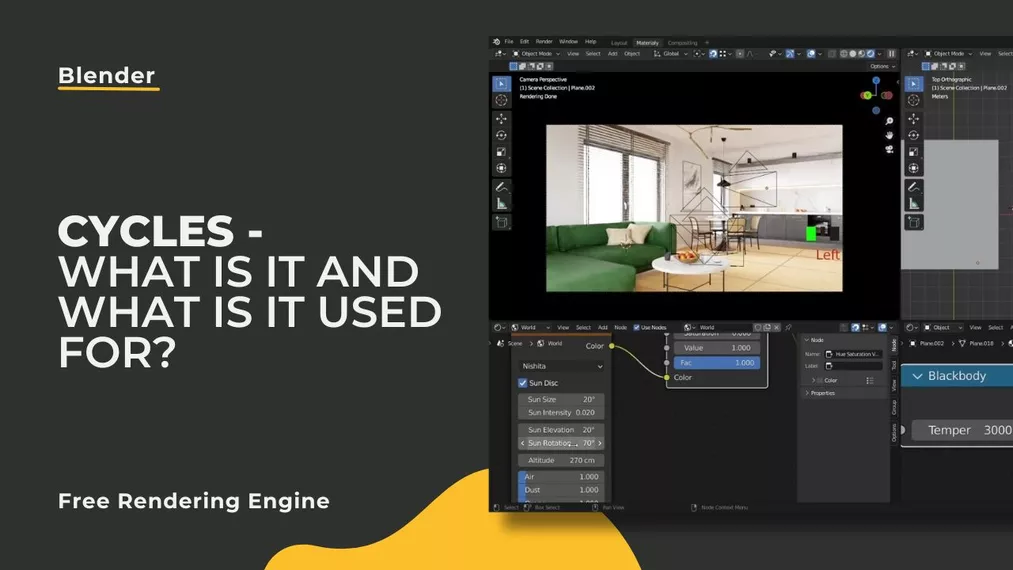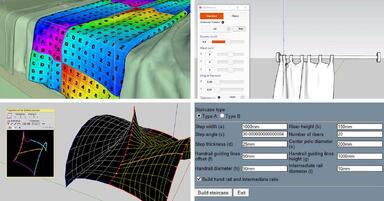Publication date: 04-02-2025 | Update date: 04-02-2025 | Author: Mateusz Ciećwierz
Cycles - What is it and what is it used for?
Cycles is one of the most advanced rendering engines available in Blender - popular, free 3D modeling software. Thanks to its power and versatility, Cycles has gained recognition among both novice users and professionals involved in creating photorealistic visualizations, animations, and special effects. In this article, we will take a closer look at what Cycles is exactly, what it can be used for, and why it's worth getting to know.

Key Takeaways
- Cycles is an advanced rendering engine based on ray tracing technology, providing realistic lighting effects.
- It is a part of Blender, meaning there's no need to install additional plugins to use it.
- Cycles allows rendering using both central processing units (CPU) and graphics processing units (GPU), increasing work efficiency.
- Supports a node-based material system, enabling the creation of complex and realistic shaders.
- It is an open-source tool, developed by the community, ensuring continuous improvement and access to new features.
What is Cycles?
Cycles is a rendering engine based on ray tracing technology, allowing extremely realistic lighting effects. It is an integral part of Blender and is used for creating high-quality 3D visualizations such as interiors, architecture, products, characters, and special effects in films. Cycles analyzes paths of light rays that reflect and scatter in space, allowing for the reproduction of complex lighting phenomena such as reflections, refractions, and shadows.
Expert's opinionJarosław PiszczekArchitekt, Grafik 3D
I have been using Blender and the Cycles engine for many years, for both interior visualization and product projects. This tool allows me to create incredibly realistic scenes with full details and natural lighting. With GPU support and an advanced material system, I can work quickly and effectively on projects that impress my clients. Blender and Cycles are a must-have in the arsenal of any 3D artist who values quality and control over the final result.
Cycles is integrated with Blender, meaning users do not need to install any additional plugins or software to start using it. Simply selecting the Cycles engine as the rendering option allows users to begin working on realistic scenes. Blender also offers another engine – Eevee, which is used for faster, less accurate visualizations, ideal for real-time preview.
What are the main advantages of Cycles?
- Realism: Cycles is an excellent tool for creating photorealistic visualizations. Ray tracing technology allows the reproduction of natural light behavior, making the renderings highly realistic.
- GPU and CPU Support: Cycles allows for the use of both central processing units (CPU) and graphics processors (GPU) for rendering. This significantly speeds up the rendering process, especially for complex scenes.
- Materials and Shaders: The Cycles engine supports an advanced material system based on nodes, enabling the creation of complex, advanced materials. Users can create and modify shaders to achieve effects that perfectly match their projects.
- Open Source: Similar to Blender, Cycles is an open-source project, meaning the developer community continuously improves it by introducing new features and enhancements. This ensures users that the engine will evolve according to their needs.
What is Cycles used for?
Cycles is used in various fields, from interior design to animation and special effects in movies. It is particularly popular among interior designers, architects, and 3D artists who value the ability to create realistic images for presenting projects to clients.
- Architectural visualizations: With Cycles, realistic interior and building visualizations that faithfully represent lighting, materials, and design details can be created. This is particularly useful for presenting projects to clients or in architectural competitions.
- Animations: Cycles is excellent for rendering animations where realistic lighting and materials are crucial. Ray tracing enables effects that are difficult to achieve using less advanced techniques.
- Product projects: Cycles is also used for creating visualizations of products that need to look as realistic as possible. Thanks to precisely replicated materials and lighting, product projects can look like photographs.
- Movies and special effects: The Cycles engine is also used in film production. Thanks to its ability to realistically reproduce lighting and materials, it is often chosen by special effects creators who need tools that allow full control over the final look of the scene.
Why choose Cycles?
Choosing Cycles as the rendering engine in Blender is an excellent solution for those who aim for a high level of realism in their projects. Its versatility, GPU support, and immense potential for creating complex materials make it an ideal tool for both professionals and beginners who want to delve into the world of photorealistic visualizations.
Whether you're designing interiors, animations, or product visualizations, Cycles offers everything you need to bring your ideas to life. Thanks to the broad user community and support for the latest technologies, Cycles remains one of the most important tools for anyone working in Blender.
If you want to learn more about rendering in Blender, explore our online courses at CG Wisdom, where you'll find comprehensive training on working with Cycles, interior visualization, and other rendering techniques. Learn how to harness the full potential of this powerful tool and take your projects to the next level.
Read on our blog
-
![Artificial Intelligence Tools in Interior Design]()
Artificial Intelligence Tools in Interior Design
Artificial intelligence is changing interior design by facilitating arrangement, visualization, and gathering inspiration. Discover the best AI tools on the market! -
![How Artificial Intelligence Helps Interior Designers?]()
How Artificial Intelligence Helps Interior Designers?
See how modern AI technologies are changing the approach to design, from automating inventory to creating inspiring visualizations. -
![10 useful SketchUp plugins you must know! Guide]()
10 useful SketchUp plugins you must know! Guide
In this text, you will learn about 10 plugins that will help you work faster and achieve better results in SketchUp. -
![Sketchup - How to create Equipe tile material? Procedural maps in V-Ray.]()
Sketchup - How to create Equipe tile material? Procedural maps in V-Ray.
The current mega-trend for rustic, ceramic tiles continues. Learn how to recreate them in visualizations in SketchUp!





